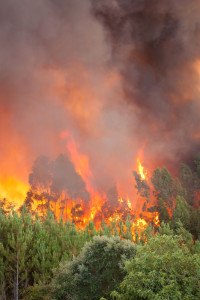As the Northwest braces for what’s expected to be one of the driest summers on record, the latest poll from Seattle-based PEMCO Insurance warns that at least one in three residents who live in the region’s most at-risk areas for wildfire haven’t taken the necessary steps to fully protect their properties – and themselves – from the threat of wildfires.
According to the PEMCO Insurance Northwest Poll, the vast majority of residents across Washington and Oregon (87 percent) share concern for the possibility of wildfires this summer, and one in five respondents (21 percent) believe there is a very real chance wildfire will directly impact their lives.
However, according to the poll, 39 percent of those who say they live in areas prone to wildfire admit they haven’t taken all of the necessary precautions to prevent the threat of wildfire around their home.
“We asked Northwest residents what they thought were the most important steps for protecting their property from wildfire, and we were surprised that about one in three said they’ve either not started or haven’t fully finished some of the tasks that prevent fires from spreading from property to property,” said Jon Osterberg, PEMCO Insurance spokesperson.
Regardless of their progress or their proximity to fire-prone areas, more than half of those polled (58 percent) agree that clearing dry brush, grasses, weeds and beauty bark from around a home is the single-most important step to safeguarding the structure against brush and wildfire.
Many wildfire prevention experts agree. According to the National Fire Protection Association (NFPA), a property’s risk hinges on its immediate surroundings – or its “defensible space” – in addition to the construction materials used to build the home. The NFPA urges residents to follow basic guidelines – known as Firewise principles – for preparing structures and landscaping to resist wildfire.
The hallmarks of a Firewise home or property include using fire-resistant landscaping materials such as rock or gravel and well-spaced, low-flammable plants, and making sure the perimeter is clear of potential fuels including tall grass, overgrown brush, dead limbs, and beauty bark.
Homeowners also should ensure the crowns of neighboring trees don’t touch, to prevent a surefire way for flames to jump from one tree to another. Brush under tree canopies and low branches should be removed to prevent them from becoming “ladder fuel,” allowing a fire to travel up the tree into the crown. Trees should be trimmed up to 12 to 15 feet, but never more than half of the total height, to maintain tree health.
Keeping the area around a home well irrigated also creates an effective defense against fire.
According to Suzanne Wade of Washington’s Kittitas County Conservation District, creating a 30-foot buffer (or more if the property is located on sloped terrain) that uses a combination of Firewise guidelines is the most critical aspect to protecting a home from fire damage.
“I urge people to manage the vegetation and other combustible materials nearest the home first, and then work out towards the property line,” Wade said. “Many homes are lost from embers rather than direct flame contact; therefore, treating the area nearest the home is vital. One ember landing on a juniper too near the home can be devastating. It’s equally important to be sure you’re doing that work now, during Wildfire Preparedness Month, before at-risk vegetation dries out more than it already has.”
Wade’s recommendations could prove to be especially critical this year given the Northwest’s mild winter. Already, Washington’s Department of Ecology projects that water runoff from melting snowpack between April and September will be the lowest on record in the past 64 years.
In Oregon, where the Buzzard Complex wildfire alone torched nearly 400,000 acres last year, two out of three residents east of the Cascades (67 percent) say they’re very concerned about the region’s lack of snowfall. Further, 44 percent of Eastern Oregonians think the low snowpack is most likely to contribute to greater danger this wildfire season.
“Everyone suffers in wildfire,” Osterberg said. “The impacts of Washington’s Carlton Complex fire last year and several bad fires in Oregon were felt across our whole region, and it’s up to us to work collectively to protect our homes and communities this summer.”
Source: PEMCO
Was this article valuable?
Here are more articles you may enjoy.

 Marijuana’s Move to Schedule III: What it Really Means for Cannabis Insurance
Marijuana’s Move to Schedule III: What it Really Means for Cannabis Insurance  J&J Talc Jury Awards $1.56 Billion to Asbestos Cancer Victim
J&J Talc Jury Awards $1.56 Billion to Asbestos Cancer Victim  ‘Door Knocker’ Roofers Were Everywhere. NC Farm Bureau Saw an Opportunity
‘Door Knocker’ Roofers Were Everywhere. NC Farm Bureau Saw an Opportunity  Flooding in California Leads to Soaked Roads, Water Rescues and 1 Death
Flooding in California Leads to Soaked Roads, Water Rescues and 1 Death 